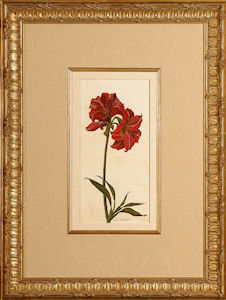Professional Picture Hanging since 1987
Yes, we hang Mirrors

51" x 98" x 1.5"
It is hanging in one of Virginia's leading engineering firms.
David LaForce
* Affordable Predetermined Rates
* More than 30 Years Experience
* Flexible Scheduling * Home or Office * Yes, we hang Mirrors
* Please Call or email for Pricing or other Information*
Great Art Deserves Great Presentation
Once your art and memorabilia has been framed, it needs to be displayed. Although it is popular today to lean pictures here and there, the most common home for frames is still on the wall. The two main things to focus on will be visual placement and making sure they are hung securely, for your safety as well as the safety of the framing itself and anything it might damage if it falls.
It is important to hang frames securely, using appropriate supplies and techniques. There are different methods you can use depending on the

Random Collections
Unlike matched sets of art, this might be something like a collection of landscape paintings, family photos, etc. In this case, frame them to suit each piece of art and hang them in a less structured way. If you may want to add to your collection, this type of arrangement makes it easier to add pieces in the future. Whether you prefer symmetry or choose an asymmetrical arrangement, it pays to create a pleasing balance of colors, sizes, styles, and textures so one side doesn’t overpower the other

Hanging Heavy Mirrors
Avoid the use of picture wire. Hang directly from strap hangers (a loop over a flat plate that screws into the frame). Rather than traditional wall hooks, use wall anchors such as EZ-Anchors, that go through the sheet rock and lock into it.
Did You Know?
Product Care - Frames

Use a feather duster or a very soft, clean cloth to keep your frames free of dust. Avoid any cleaning products and abrasive towels that may scratch the frame. If something splatters onto a frame, remove it immediately with a soft, barely damp rag. Try not to handle gilded frames unless your hands are very clean as oil in the skin can leave spots that may discolor with time.
Liners
Fabric wrapped liners may be difficult to feather dust. You may actually push the dust into the grain of some fabrics. Instead, try a vacuum with a soft brush attachment or compressed air like you may use to clean a keyboard.
Product Care - Mats
If you have a matted piece that is not yet framed, avoid touching it unless your hands are clean. Oil in the skin can leave spots that are difficult to remove. If a spot does appear, try to blot it with a dry white paper towel.
Once a mat is placed behind glass or acrylic, it is still susceptible to other forms of damage. Ultra-violet light rays can accelerate the fading of many mats. Use conservation grade glass or acrylic to protect the art and mat as much as possible. Excessive moisture and temperature changes can cause water stains, mold and buckling. Inspect your framed art regularly to avoid irrepairable damage.


All About Frames at Rivertowers
6641 Wakefield Drive #115
Alexandria, Virginia 22307
703-901-2012 aaframes@gmail.com
Product Care - Glass


The way you care for the glass covering your framed art may depend on what type of glazing was used. The piece shown here has three types of glass on it, showing you the differences in reflectivity. What you can't see is the difference in UV filtering to protect the art. The "Museum Glass" shown in the middle looks nearly invisible and protects the art, too.
All About Frames can provide specific directions for appropriate cleaner or cloths. In general, simply leave the framed piece alone with the exception of periodic cleaning. Feather dusting helps remove dust particles that may land on the glass. You can also use a soft lint-free cloth or soft paper towels and glass cleaner/rubbing alcohol and water a70/w40 mix. Never spray the cleaner on the glass. Instead spray onto the rag and then wipe the glass.
Closely inspect the glass on a regular basis to see if it appears clear on the inside too. Various chemicals in dyes and inks used to make prints and mats can potentially off-gas. This may result in a cloudy residue on the inside of the glass. You can bring it to All About Frames to have it opened up, cleaned and placed pack in the frame.
Product Care - Acrylic
Acrylic is an alternative you can choose instead of glass. It is much less likely to break and if it does, it won't shatter into hundreds of pieces. The downside can be the ease with which acrylic can be scratched. Avoid cleaning it with abrasive cleaners or abrasive cloths. There are abrasion ressistant and UV filtering acrylics available.
The best way to take care for acrylic is:
- feather dusting
- acrylic/plastic cleaner
- soft, non-abrasive cloths
Our best advice is to clean it before it appears to need it. If you have to rub hard to remove particles or smudges, you increase the chance of damaging the finish.

